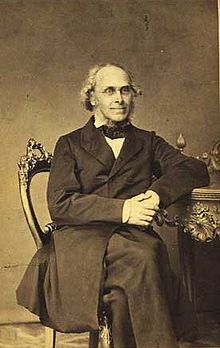Niels Ludwig Westergaard
Niels Ludwig Westergaard (born October 27, 1815 in Copenhagen , † September 10, 1872 ) was a Danish orientalist .
Life
Niels Ludwig Westergaard studied Old Norse and Sanskrit in Copenhagen and continued his studies in Bonn (with Christian Lassen ) in 1838 and in London , Paris and Oxford in 1839 . Shortly after returning to his homeland, he published his work Radices linguae sanscritae (Bonn, 1841) u. the treatise On the connexion between Sanskrit and Icelandic (Copenhagen, 1841–1844), following on from the research of his famous compatriot and predecessor Rask .
With the support of the king and the university, he undertook a trip to India and Persia in 1841, from which he returned in 1844 under the greatest privation over the Caucasus and Moscow, after visiting the antiquities there in the Bombay presidency and doing a thesis on the inscription of the Buddhist King Ashoka published at Giruar , visited the Parse communities in Bombay and later in Persia and obtained some Zend and Pehlewi manuscripts from them and took exact copies of the local cuneiform inscriptions of the Achaemenid kings in Persepolis .
He succeeded in the latter work only by observing the inscriptions affixed to a rock at a height of 60-70 feet with the help of a very powerful telescope in the morning light, during which he developed a violent fever.
On his return, he was appointed lecturer in 1844, and in 1845 associate professor of Indian-Oriental philology at the University of Copenhagen . He now turned first to deciphering the so-called. second genus of cuneiform inscriptions . His treatise on the deciphering of the Achaemenid cuneiform inscription of the second genus (in the 6th volume of the Zeitschrift für die Kunde des Morgenlandes ) was, despite some mistakes, the first reasonably successful work in this difficult area, to which he later devoted an important investigation (in the writings of the royal Danish Society of Sciences 1854).
For the use of his students he published a handbook for the study of Sanskrit in Danish in 1846, in the same year he published a catalog of the oriental manuscripts of the Copenhagen University Library in Latin. The main work of his life is his edition of the Zendavesta (London, 1852–54), the first complete edition of this important religious book. Already in 1851 he had another significant religious book of the Parsis, the documents drawn up in Pahlavi league Hash published. He later turned back to Indian studies and, in addition to smaller works, published the important text On the oldest period in Indian history (Breslau, 1862).
Elected to the constituent imperial assembly in 1848, he was temporarily active in politics. In the academic year 1867/68 he was rector of the University of Copenhagen.
Works
- On The Deciphering Of the Second Achñmenian Or Median Species Of Arrowheaded Writing (1840)
- Radices linguae Sanscritae ad decreta grammaticorum definivit atque copia exemplorum exquisitiorum illustravit (1841)
- Orientales bibliothecae Regiae Havniensis jussu et auspiciis Regis Daniae Augustissimi Christiani VIII. Enumerati et descripti (1846)
- Kortfatt Sanskrit Formlaere (1846)
- Sagan af Hrafnkeli Freysgoòa (Copenhagen, 1847)
- Bundehesh, liber Pehlvicus ( Gyldendal , 1851)
- Inscriptiones duœ Regis Saporis primi, prope a vico Hâjiâbâd incisœ (Copenhagen, 1851)
- Contribution to ancient Iranian mythology (translated from Danish by Friedrich Spiegel, Berlin, 1855)
- Om de ældste Tidsrum i den indiske Historie med Hensyn til Literaturen (Copenhagen, 1860)
- About the year of Buddha's death (1862)
- Zendavesta or the religious books of the Zoroastrians
- The Zend texts
- Bidrag til de indiske Lande Málavas og Kanyakubjas history 1868
literature
- Niels Ludwig Westergaard . In: Carl Frederik Bricka (Ed.): Dansk biografisk Lexikon. Tillige omfattende Norge for Tidsrummet 1537-1814. 1st edition. tape 18 : Ubbe – Wimpffen . Gyldendalske Boghandels Forlag, Copenhagen 1904, p. 452 (Danish, runeberg.org ).
Web links
- Literature by and about Niels Ludwig Westergaard in the catalog of the German National Library
Individual evidence
- ^ List of rectors on the University of Copenhagen website
| personal data | |
|---|---|
| SURNAME | Westergaard, Niels Ludwig |
| BRIEF DESCRIPTION | Danish orientalist |
| DATE OF BIRTH | October 27, 1815 |
| PLACE OF BIRTH | Copenhagen |
| DATE OF DEATH | September 10, 1872 |
